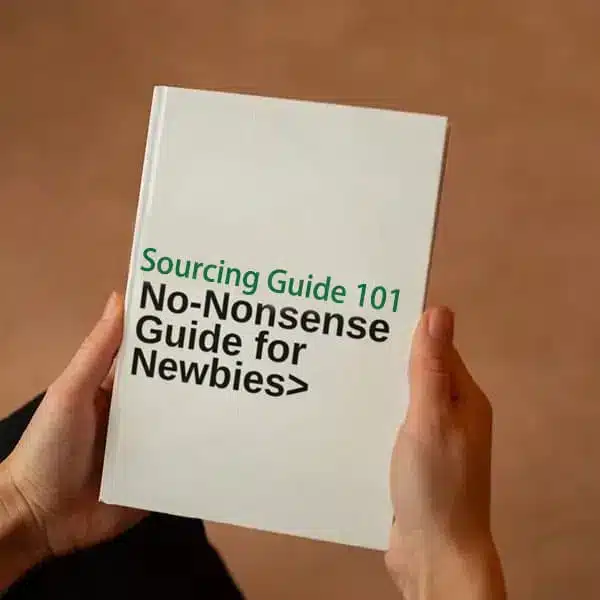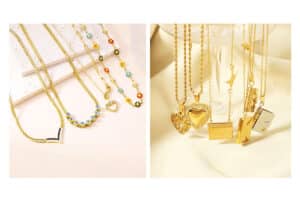While Chapter 4 showed you powerful ways to find suppliers online, there comes a point where nothing beats seeing things for yourself. Visiting China offers unique advantages: you can physically touch products, check out factory quality firsthand, build stronger personal relationships with suppliers1, and potentially discover unique items or manufacturers not easily found online. For many businesses serious about long-term importing, especially those needing customization or developing new products, a trip can be invaluable.
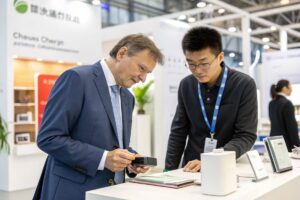
However, for first-time visitors or those new to importing, navigating China can seem like a big challenge – language barriers, cultural differences, and simply knowing where to go can feel overwhelming. Don’t worry! With a bit of planning, it’s absolutely manageable and highly well worth it.
Let’s break down how to effectively find suppliers by making the trip.
Pre-Trip Essentials – Getting Ready for China
A smooth trip starts with preparation. Here are a few key things to sort out before you board your flight:
- Check Entry Requirements: Visa rules and entry policies can change. Always check the latest requirements with the Chinese embassy or consulate in your country well in advance. Ensure your passport is valid for at least six months beyond your planned stay.
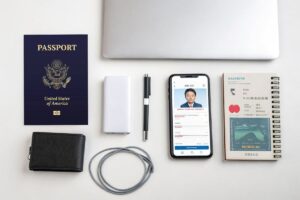
Get a Reliable VPN: Access to familiar websites and apps like Google, Facebook, WhatsApp, Instagram, and YouTube is blocked in mainland China. To stay connected and access these tools, you must install and test a reputable VPN service on your phone and laptop before* you leave home. Options like ExpressVPN, Astrill VPN, or NordVPN are popular choices (check current reviews and reliability).
-
Plan for Communication (Interpreter): While some salespeople at major fairs might speak English, don’t rely on it, especially when visiting markets or factories.
-
Basic Tools: Translation apps (first recommend AI such as chat GPT, Gemini, Deepseek,and so on, or some old tools like Google Translate – accessible via VPN, or local apps like iFlytek Voice Input if you can navigate them) can help with simple phrases.
-
Professional Interpreter2: For serious business discussions, negotiating details, or visiting factories, hiring a professional interpreter is highly recommended. Expect costs around $100 – $200+ per day depending on location and experience. This investment pays off massively in clear communication and avoiding misunderstandings. You can often find interpreters through agencies, online platforms, or recommendations from your hotel or business contacts.
-
Power in Numbers – Finding Suppliers at Trade Shows
Attending major trade shows is arguably the most efficient way to meet a large number of potential suppliers in a short time, no matter your business size.
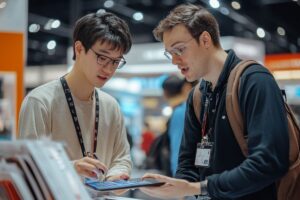
- Why Trade Shows are Effective:
- See & Touch: Physically examine products (like our Customizable Wireless Charging Pad), assess quality, and compare different suppliers side-by-side.
- Direct Interaction: Meet manufacturers and trading companies face-to-face, ask detailed questions, and get an exact feel for how professional they are.
- Discover Trends: See the latest products and innovations in your industry.
- Efficiency: Packs weeks of online searching into just a few days of focused meetings.
- Key Trade Shows:
- Canton Fair (Guangzhou)3: The largest and most famous comprehensive trade fair in China, held twice a year (Spring & Autumn) in three phases, covering almost every product category imaginable (Phase 1: Electronics, Industrial; Phase 2: Consumer Goods, Gifts, Home Decor; Phase 3: Textiles, Medical, Food). Plan your visit based on the phase relevant to your products (Phase 1 is key for electronics).
- Hong Kong Trade Shows4: Hong Kong hosts many world-class specialized fairs, often scheduled around the Canton Fair. Popular ones include:
- HKTDC Hong Kong Electronics Fair
- HKTDC Hong Kong Gifts & Premium Fair
- Global Sources Shows (Electronics, Lifestyle, etc.)
- Mega Show (Gifts, Housewares, Toys)
- Advantage: Easy travel between Hong Kong and nearby mainland cities like Shenzhen and Guangzhou makes attending fairs in both locations feasible.
- Finding Other Shows: Look for industry-specific fairs relevant to your niche. Use online trade show directories (like 10times.com, ExpoPromoter, or specific industry association websites) to find events focused on consumer electronics, mobile accessories, or corporate gifts if you’re sourcing customizable wireless charging pads.
- Tips for Success at Trade Shows:
- Prepare: Know your product specs (e.g., charging speed, materials), target price range, and desired quantities. Bring professional business cards.
- Be Focused: Fairs are huge. Plan which halls and exhibitors to visit beforehand (focus on electronics zones).
- Collect Info: Gather catalogs and business cards5. Take notes and photos (ask permission first).
- Initial Contact: Use the show for introductions and initial screening. Detailed negotiations often happen after the show.
- Sample Policy: Ask about sample availability and costs. Some suppliers sell samples at the show; others require follow-up orders.
Market Immersion – Sourcing from Wholesale Markets
Beyond the organized chaos of trade shows, exploring China’s vast wholesale markets6 offers another way to find suppliers, especially for ready-made goods or smaller quantities.
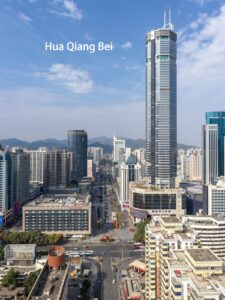
- Why Wholesale Markets?
- Product Variety: See a massive range of finished goods concentrated in one area.
- Lower MOQs: Often possible to buy smaller quantities than direct factory orders.
- Immediate Purchase: Sometimes possible to buy stock on the spot (though often requires arranging logistics).
-
Key Regions & Markets (Shifting Focus):
- Yiwu International Trade City7: Still the world’s largest market for small commodities (jewelry, toys, decorations, general merchandise). Worth knowing, but less relevant for specialized electronics like wireless chargers.
- Guangzhou Markets: Clusters of markets specializing in specific categories like apparel, leather goods, watches, and cosmetics. Less focus on core electronics components, though some accessories might be found.
- Shenzhen & the Pearl River Delta8 (PRD) Powerhouse: While Shenzhen’s Huaqiangbei is legendary for electronics components, the entire PRD (including Dongguan, Foshan, Guangzhou) is the undisputed heart of China’s most advanced and complete manufacturing ecosystem, especially for electronics.
- The PRD Advantage: This is where the magic happens for product development and complex manufacturing. Need a specific charging coil specification, a custom PCB layout, a particular plastic resin for the housing mould, specialized finishing like soft-touch coating, and precise logo printing for your customizable wireless charging pads? In the PRD, you can realistically find specialized suppliers for every single component, often within hours. This allows for incredibly rapid prototyping, iteration, and efficient production scale-up – a capability unmatched anywhere else in the world. Visiting this region allows you to tap directly into this powerhouse, especially the numerous electronics factories in Shenzhen and Dongguan.
- Visiting Wholesale Markets:
- Be prepared for crowds and lots of walking (especially in Huaqiangbei if looking for components or standard models).
- Many vendors are traders, not direct factories.
- Prices are often negotiable, especially for larger quantities.
- An interpreter is usually essential.
Going Direct – Exploring Industrial Clusters
For importers seeking direct relationships with manufacturers, better pricing, and deeper insight into production, visiting specific industrial clusters9 is the ultimate goal.
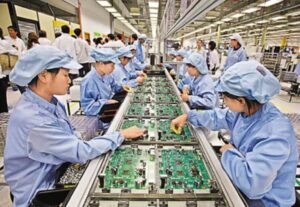
- Why Industrial Clusters?
- Factories making similar products often group together geographically (e.g., a district known for mobile accessories in Shenzhen, an area in Dongguan specializing in plastic injection molding).
- This concentration fosters a specialized workforce, efficient raw material sourcing, and intense competition – often leading to better quality and pricing for electronics.
- It allows you to cut out middlemen and deal directly with the source.
- How to Locate Clusters for Your Product:
- Use Online Clues: Search for your product (e.g., "customizable wireless charging pad manufacturer") on Alibaba. Look at the listed "Supplier Location" or company addresses in the profiles of multiple verified suppliers. If you repeatedly see the same city or district (e.g., Bao’an in Shenzhen, or specific towns in Dongguan), that’s likely a key cluster for electronics manufacturing.
- Ask Your Network: Inquire with potential suppliers, your interpreter, or a sourcing agent (like Green Sourcing!) about the main manufacturing hubs for consumer electronics and charging accessories.
- Visiting a Cluster:
- Plan Ahead: Identify specific factories you want to visit based on online research or recommendations. Schedule appointments in advance.
- Travel: Clusters can be in specific districts or industrial zones, requiring specific travel arrangements (car, taxi, metro).
- Factory Tour: Observe their production lines (SMT lines, assembly, testing), quality control processes, scale, and certifications (like CE, FCC, RoHS). Discuss your specific needs (customization for the wireless charging pads like power output, case materials, branding options), overall quality control, production capacity directly with management or engineers.
- Benefit: Gain unparalleled insight, build strong relationships, and potentially secure the best partners for long-term business. This is often the most time-consuming but potentially most rewarding method for complex products like electronics.
Conclusion
Visiting China to find suppliers adds powerful dimensions that online sourcing alone can’t replicate. Whether you immerse yourself in the vastness of a trade show like the Canton Fair, navigate the specialized wholesale markets like Shenzhen‘s Huaqiangbei or engage with the dynamic PRD manufacturing ecosystem, or go directly to the source by visiting factories in industrial clusters, being physically present allows you to verify quality, build trust, and unlock opportunities. It requires more planning and investment than online methods, but for businesses serious about growth and control over their supply chain, especially for products like electronics, the insights and connections gained are often invaluable.
-
Discover strategies for fostering strong relationships with suppliers, which can lead to better deals and collaboration. ↩
-
Hiring a professional interpreter can greatly enhance communication and understanding during business meetings in China. ↩
-
Learn about the significance of the Canton Fair for sourcing products and connecting with suppliers in various industries. ↩
-
Discover the key trade shows in Hong Kong that can help you network and find new suppliers effectively. ↩
-
Explore effective strategies for utilizing business cards to enhance networking and connections at trade shows. ↩
-
Discover the advantages of sourcing products from wholesale markets, including variety and lower minimum order quantities. ↩
-
Learn about the world’s largest market for small commodities and how it can benefit your sourcing needs. ↩
-
Explore why this region is the heart of advanced manufacturing and how it can enhance your product development. ↩
-
Learn about the advantages of visiting industrial clusters, which can enhance your sourcing strategy and improve product quality. ↩


